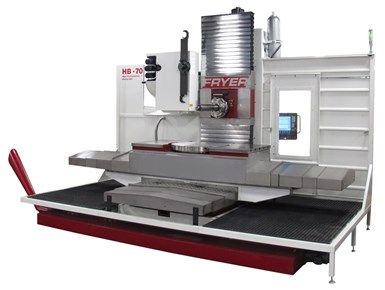Fryer’s Horizontal Boring Mill Designed for Ease of Use
The HB Series Boring Mills feature rugged cast iron bodies and high-precision ballscrews and bearings to ensure high-accuracy tolerances.
Share





Fryer Machine Systems’ HB Series Boring Mills are built in the U.S. and designed for fast setup and simplified shopfloor programming. Fully manual operation makes one-off part production quick. “Do One” mode enables single-cycle operation with no programming. “Full Conversational” mode and “G-code” mode provide rapid programming.
The HB Series are equipped with rugged cast iron bodies and high-precision ballscrews and bearings to ensure high-accuracy tolerances. Fryer HB Mills feature 50-taper, 4"-diameter bar/quills with 20" of W-axis travel and 40 HP, 3,000 rpm spindle motors with 360 ft./lbs. of torque. Built-in rotary tables enable multi-side machining.
Box ways on all three axes provide high rigidity and minimize vibration to extend tool life. All friction surfaces are Turcite coated, oil fed and slide on top of the box ways to reduce wear and increase accuracy. The Meehanite castings are machined twice and stress relieved.
The Fryer-Siemens CNC enables shopfloor programming for single-piece runs or G-code programming for high production. “Do One” cycles eliminate manual set-ups by enabling users to automatically thread, rough, turn, drill and tap, one step at a time. Regenerative drives can also save over 40% on electricity, according to Fryer.
Fryer HB machines are built for high performance cutting, accuracy, reliability and ease of use. All axes are laser calibrated and ballbar verified with printed results shipped with every machine. Fryer guarantees its machine quality with a one-year warranty on its HB Boring Mills.
Related Content
-
Lean Approach to Automated Machine Tending Delivers Quicker Paths to Success
Almost any shop can automate at least some of its production, even in low-volume, high-mix applications. The key to getting started is finding the simplest solutions that fit your requirements. It helps to work with an automation partner that understands your needs.
-
Inside the Premium Machine Shop Making Fasteners
AMPG can’t help but take risks — its management doesn’t know how to run machines. But these risks have enabled it to become a runaway success in its market.
-
Orthopedic Event Discusses Manufacturing Strategies
At the seminar, representatives from multiple companies discussed strategies for making orthopedic devices accurately and efficiently.

























.jpg;maxWidth=970;quality=90)